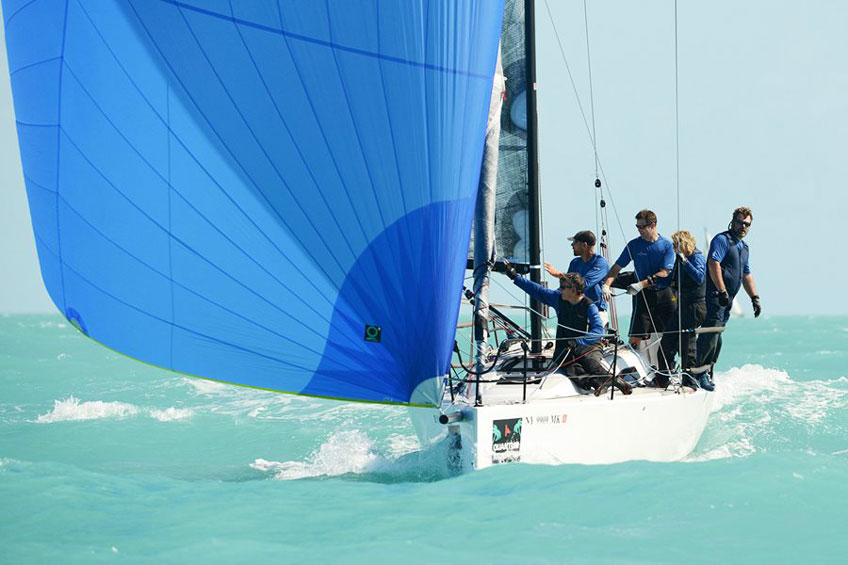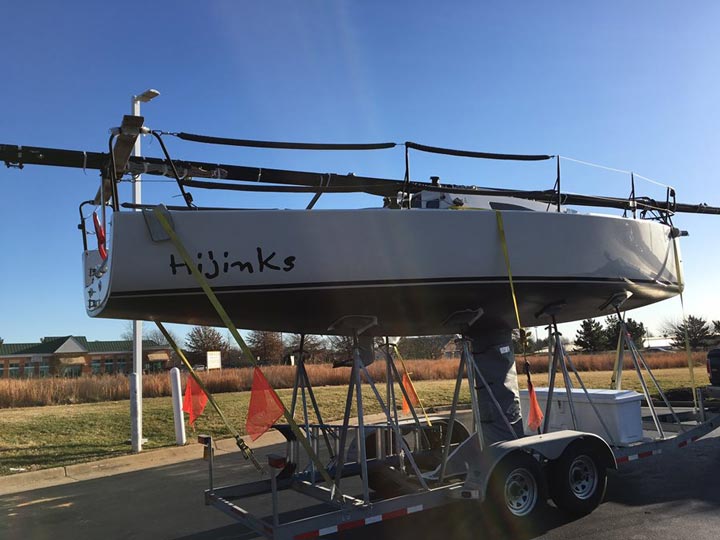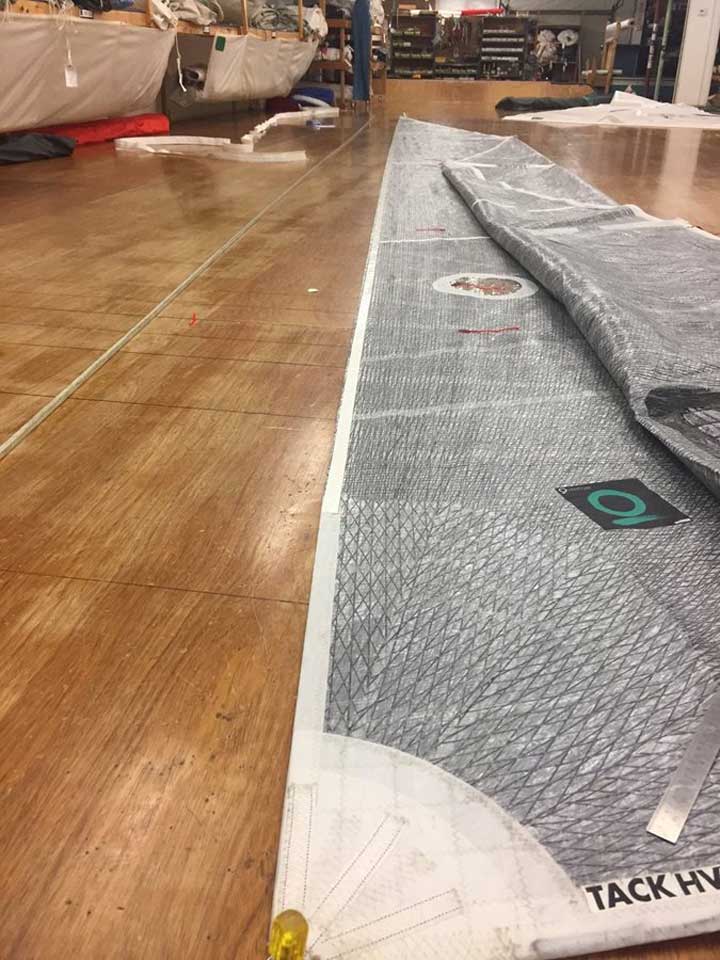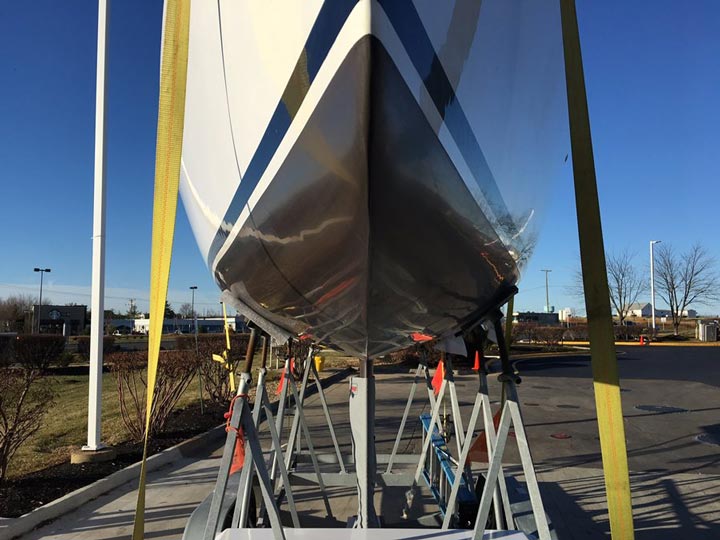Kris Werner leads the team at Quantum Sails Rochester and boasts a deep sailing resume. When new J/88 owner Laura Weyler set her sights on her first Quantum Key West Race Week, Kris knew exactly what to do to get her there.
 Hijinks dominated at their first Quantum Key West Race Week. Photo by PhotoBoat.com/Quantum Key West Race Week.
Hijinks dominated at their first Quantum Key West Race Week. Photo by PhotoBoat.com/Quantum Key West Race Week.
Laura Weyler’s first Quantum Key West Race Week was more than she and J/88 team Hijinks could have hoped for; we didn’t just make it down there and race without any major hiccups, we won Lewmar Boat of the Day and the whole J/88 class. It was a lot of work and a lot of fun. Here’s how we did it.
It’s a Date
Last fall, Hijinks owner Laura Weyler decided to add the 2017 Quantum Key West Race Week to her J/88 campaign. Having done Key West several times, I knew the effort required just to get to the starting line in Key West, not to mention succeeding. At Quantum Sails Rochester, we not only handle new sails, canvas, sail repairs, rigging, and hardware, we offer support and expertise to help our customers conquer any challenge. I offered to help Laura with Key West, and she trusted our loft to coordinate the effort with her.
Now What?
The first step was determining the overall goal. Every campaign wants to win, but was that priority one? We needed to define and communicate our top priority. For Key West, fun was the number one goal, but having a boat and crew capable of winning was a close second.
I sat down with Laura and discussed what it would take financially to meet her goals. The unfortunate part of sailboat racing is the cost, particularly on the road. It’s important to keep in mind what’s necessary versus what’s over-the-top. There are many moving pieces, from the boat to crew to travel. We considered all of those factors, as well as the costs. We wanted to make sure she was confident with her set-up, but also that her time on the water was fun and worth the investment.
A Few Good Crew
Who’s going to join you? When you’re on a budget and looking for crew for a major regatta, consider these things:
- What are the minimum/maximum crew needed to sail competitively?
- Base the crew minimum on what other teams will be using. You can’t take everyone, but in case of heavy winds or injury it doesn’t hurt to have an extra. Enlist an extra sailor to join you as shore crew. It’s helpful to have the support, and he/she can jump in if anything hits the fan. This is a good role for that up-and-coming sailor or college kid who wants to participate in a major event.
- Keep target weight and limits in mind!
- Crew location: If you don’t already have a team, or you’re short a member, look at the regatta location. Local sailors know the area and conditions well, and they can be valuable assets.
- Professional limits – how many Cat 3 (pros) allowed? If you’re allowed to have pros on board and you can afford it, take advantage! If you need help finding someone, your loft can help.
- Compatibility: If you don’t click, you won’t have fun, and you won’t be an effective team. If you can’t sail with a new team member beforehand, ask for a few references or grab a beer together before hitting the water.
- Positions: Keep positions and role specialties in mind as you choose your crew. Make sure everything’s covered so you’re not learning while racing.
- Commitment: Can they commit to a full season and become a regular part of the team?
Laura’s team included six people and targeted 1180 pounds (proposed class max weight limit). All of us had sailed with at least two of the other crew previously, we had one Cat 3 pro (per J/88 class rules), and five sailors from Laura’s area. Everyone was able to commit to the long-term goals as team.
Planes, Trains, and Automobiles
Once the team was finalized, we needed to book our tickets. We were early enough to get good fares directly into Key West and avoid the three-hour drive from Miami or Ft. Lauderdale (five of us even managed to land at the same time!). Plan the best way to get to the event (it’s not always flying), but watch out for low-cost options that are time and stress costly!
Once you arrange for your crew to get there, it’s boat-logistics time. If you’re transporting the boat yourself, it’s an easy decision for you and a crew member to accompany it. However, for many larger vessels, it’s best to hire a service. Regardless of who is driving, make sure your trailer is in top shape.
 Hijinks is secured and ready for the journey south with a trusted operator.
Hijinks is secured and ready for the journey south with a trusted operator.
To transport her boat, Laura reached out to JP Boatworks in Rochester. They transport boats all over the U.S., and they rig the boats too! It’s not as cheap as doing it yourself, but it was worth the peace of mind and ease.
When it’s time for on-site logistics, talk to a local for some insider information. Consider the costs you might incur, but also consider time and convenience. If you book the cheap hotel across town, how will you get to the docks? Will you need to rent a car? Will the long trips to-and-from the docks make it hard for your team to be effective and efficient? Things to consider include:
- Prior experience at a location
- Distance to the venue (the closer the better)
- Cost
- Where will you eat?
- Can you keep food on the boat?
- Parking and commuting logistics
If you don’t have a local resource, call the local loft or marina. Laura talked to local sailors and found great accommodations that checked all the right boxes. We stayed close to regatta HQ and our boat dock. Each crew chimed in about what foods they wanted, and all the meals were planned out. We ate out twice and cooked for ourselves the other nights.
 It's amazing what a luff recut can do to update a sail!
It's amazing what a luff recut can do to update a sail!
And Now the Boat Prep
It’s great to have new hardware and sails, but the gains are not always worth the cost. When it comes to sails, you can prolong sail life or breathe life back into them – especially if recuts are an option! We inventoried and reviewed Laura’s program and were lucky the boat and sails were generally new and well-prepared. Things we looked at included:
- Condition of existing sail inventory: Look at everything! Figure out what needs updates, repairs, or to be replaced.
- Fill missing inventory: Make sure you have the right sails for the conditions and class.
- Pictures: Photos of your sails on your boat help you know if the shape, trim, or tuning are issues.
- Label and store sails: Bag, tag, and store sails. Make sure they’re where they need to be to get to the event (on the boat, shipped, etc.).
Laura had all the sails inspected at the loft: the mainsail, two jibs, and two spinnakers. She bought the boat with most of the inventory, so it wasn’t all new, but it wasn’t all bad. We worked with the Quantum's J/88 designer to get updated luff offsets for the outdated J2/3, and we re-faired the sail to the new design. We also made some repairs to the heavy air spinnaker. We only replaced one spinnaker and the mainsail. This approach saved significant money versus buying a new inventory. It wasn’t all new, but it was solid.
Bottom and Rig Prep
Prep as much as possible before leaving, giving every section of the boat attention. When it comes to the bottom, make sure it and the foils are as smooth as possible. If not, make a plan to fix it.
Hijinks’ bottom was not competition-ready. It was pretty much stock from the factory, so we sent it to the pros at Waterline Systems. It can be expensive to have the bottom professionally prepared, but it should be a one-time expense with minor upkeep. It also provides peace of mind knowing that your hull and foils are fully optimized.
 If your bottom isn't competition ready, it's an investment worth making.
If your bottom isn't competition ready, it's an investment worth making.
Make sure to reserve time to check the rigging. If the boat is being trailered, the mast will be down, but that doesn’t mean you can’t inventory and check the halyards/sheets. They should have high tech/low stretch materials and solid working shackles. Make sure everything is set up as efficiently as possible, and make sure the mast, boom, spreaders, and shrouds are in good order.
Laura’s boat is new to her, but, at only three years old, was in relatively good order. We needed to replace the jib sheets with new ones, and we added some shackles and new deck hardware to accommodate cross sheeting the jib to the weather side. The team sailed to determine exactly what worked and what could be improved before making the final to-do list.
We were extremely lucky that the boat also included the latest B&G instrument system. We contacted B&G and had a representative come check everything to make sure it was one-hundred percent. We planned how to use the system, then picked a crew member to be in charge of it, knowing it inside and out and troubleshooting it as needed.
In Conclusion
Remember, the better prepared you are, the more time you have to spend on the water and enjoying your event. After all, isn’t that the reason we travel to new, exciting places? All in all the 2017 Quantum Key West Race Week checked all the boxes; not only did we have a blast (our main goal!), everything went smoothly and we won our class. Until next year!